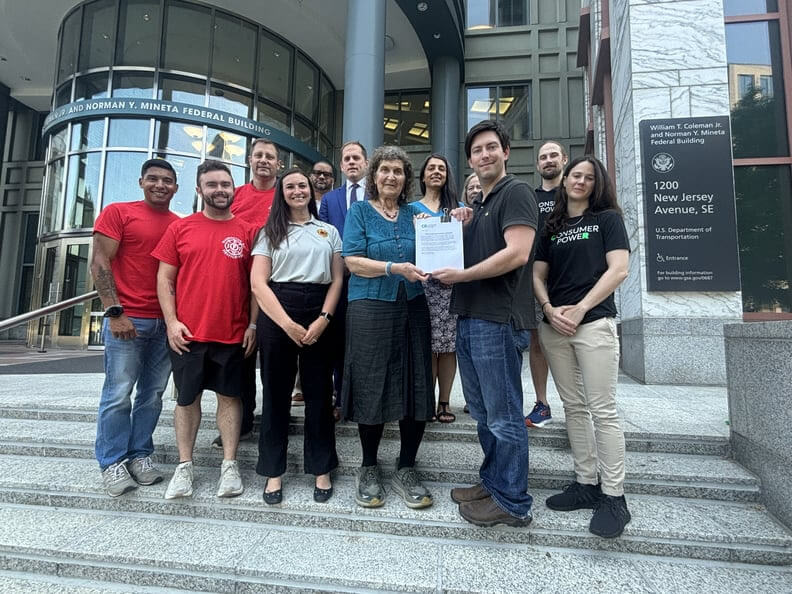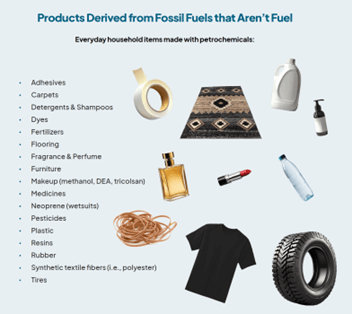October 2024: Big Honor, Big Week
In this edition:
- Are Your Kitchen Utensils Contaminated by Electronic Waste?
- Are PFAS a Hidden Risk for COVID?
- Perils of the Petrochemical Pivot
- Flame Retardants Beware! Out of Our Couches
- Green Science Policy Institute in the News
I hope you are having as good an autumn as possible while awaiting the upcoming critical U.S. election.
I was recently very surprised and honored to be selected among world leaders and CEOs for the inaugural Forbes Sustainability Leaders list. The magazine wrote: “For the first time, Forbes is highlighting 50 superstar entrepreneurs, scientists, funders,
policymakers, and activists … Forbes inaugural Sustainability Leaders span industries and disciplines while all demonstrating exceptional ambition, innovation, & recent, tangible impact ....”
Most of these fifty leaders are focused on climate, so I'm pleased to represent toxics. Climate and toxics are closely related as we wrote in our New York Times op-ed “If We Stop Burning Fossil Fuels, Will We End Up with More Plastic and Toxic Chemicals?” You can view the full of Forbes Sustainability Leaders list here and my write-up here.
In sad news, the noted UC Berkeley biochemistry professor Bruce Ames passed away this month. He was a great mentor for me—so creative, passionate, and generous about using science for the greater good. His New York Times obituary mentions our 1977 Science paper Flame-retardant additives as possible cancer hazards stating: “his work made headlines when he discovered that a chemical called Tris, used to make children's pajamas flame-retardant, caused genetic mutations.
By some estimates, 45 million children were wearing Tris-treated pajamas." Three months after our paper was published, the Consumer Product Safety Commission banned children’s pajamas containing Tris. This success in translating scientific research into positive change inspired our Institute’s current strategy to reduce chemical harm.
And back in 2006, when I was searching for how to get back to scientific research after a 26-year-long absence, my path was facilitated by learning that the very same Tris flame retardant that Bruce Ames and I had removed from children’s pajamas in 1977 was back in our nation’s furniture and baby products. After success in stopping this harmful exposure to our population from furniture, our car study with Duke University found similar cancer-causing and neurotoxic flame retardants in all of the 101 cars we studied.
Along with Consumer Reports and the International Association of Fire Fighters, we are now petitioning the National Highway Traffic Safety Administration (NHTSA) to change vehicle flammability standards to prevent this unnecessary chemical exposure inside our cars. I will be forever grateful to Bruce Ames for his innovation, enthusiasm, and inspiration.
Anna and I have just returned from a fruitful trip to Washington D.C., where we met with congressional staff and government agencies to discuss strategies for reducing harm from antimicrobials, flame retardants, and PFAS.
We especially appreciated the opportunity to present to the Food and Drug Administration (FDA). Just weeks earlier, we sent a letter from more than 40 environmental health organizations urging the FDA to make a decision on whether it will continue to permit the use of the remaining three antimicrobial chemicals allowed in over-the-counter hand and body washes. The agency was due to make its decision on these chemicals seven years ago, and during this time, evidence has grown showing their health harm—but not their effectiveness.
In fact, the CDC instructs the public to use plain soap and water to wash hands, noting antibacterial soaps “are no better than plain soap at preventing people from getting sick and their ingredients may not be safe for long-term, daily use.” We were heartened by the opportunity to share with the FDA the latest concerning science about the frequently used antimicrobials that underscores the importance of FDA reaching a decision.
Another topic of our meetings was the use of flame retardants in lithium-ion battery enclosures. You can learn more about this problem and possible solutions from our new webpage, “Flame Retardants in Battery Enclosures.”
I invite you to subscribe to our YouTube channel to watch brief educational videos about harmful classes of chemicals, recordings of our favorite webinars and meeting presentations, memorable interviews, and more. For example, you can view my talk at Duke University from a couple weeks ago here.
Finally, our Institute is still taking applications for a Principal Scientist to be my thought partner and to work with our team on our science and policy projects. You can learn more on our Jobs page.
Kind regards,
Arlene and the Green Science Policy team
P.S. Please remember that nothing is more important for our health, environment, and democracy than voting. Our friends at Walk the Walk have a list of excellent late-breaking volunteer opportunities to support voting. Please consider signing up to help today, either in-person or remote, and asking a friend to join you. Your efforts can make a difference.
Are Your Kitchen Utensils Contaminated by Electronic Waste?
By Lydia Jahl
Take a look in your kitchen – are there any utensils made of black plastic? If so, there’s a good chance they contain harmful flame retardant chemicals. The non-profit Toxic-Free Future recently investigated household goods made with black plastics purchased in the United States for the first time. Unfortunately, the products they tested – like kitchen utensils, toys, food containers, and hair accessories – often contained brominated flame retardants.
How do flame retardants even get into these products? Plastics recycling – though a good goal – leads to such contamination, especially with the lack of material transparency and testing that we have in the US. The researchers also discovered that the plastics commonly used for electronics (such as TV cases) contained higher flame retardant levels than the plastics used in other products. This is because flame retardants are often needed in electronics to meet flammability standards, even when there is only an assumed benefit (like we recently discovered in lithium-ion battery enclosures).
While the environmental health community works towards better transparency, cleaner recycling, and safer electronics, you can help reduce your exposure from recycled plastics. Choose utensils made of stainless steel or wood, do not heat food in plastic, and try to limit the amount of plastic in your children’s toys.
Are PFAS a Hidden Risk for COVID?
By Ariana Spentzos
A recent study from Harvard University has revealed a concerning connection between PFAS contamination in drinking water and increased COVID-19 mortality rates in various US counties. Earlier research has shown that PFAS have been linked to negative health effects on the immune system.
In this paper, the researchers analyzed data from county-level COVID-19 mortality records in the pre-vaccine era alongside drinking water monitoring data to assess the impact of PFAS exposure. Their findings indicate that higher levels of PFAS in drinking water are associated with increased COVID-19 deaths. This research highlights the importance of addressing environmental contaminants and their possible impact on the severity of infectious diseases.
As we continue to tease out further negative health effects associated with PFAS exposure, this work helps to underscore the importance of the recent EPA regulations that set the allowable amount of six different PFAS chemicals. Further monitoring of a broader range of PFAS will help enable future research like this and increase our understanding of the role of environmental factors in human health. This is crucial for developing effective public health strategies and ensuring safe drinking water for everyone.
Perils of the Petrochemical Pivot
By Rebecca Fuoco
As the world transitions to clean energy, fossil fuel companies are increasingly focusing on petrochemical production. Petrochemicals serve as the building blocks for a vast array of products, including plastics, synthetic fabrics, paints, insulation, fertilizers, and pharmaceuticals. This strategic shift allows the industry to continue utilizing cheap oil and fracked gas while extending the life of fossil fuel infrastructure. Unfortunately, this pivot is undermining climate progress and creating harmful pollution.
A new analysis from the Center for International Environmental Law (CIEL) reveals that planned petrochemical projects could contribute a staggering 153.8 million metric tonnes of CO₂ emissions annually. To put that in perspective, that’s equivalent to the emissions of nearly 40 coal power plants or all domestic commercial aviation emissions in the U.S.
The petrochemical buildout isn't just a climate issue - it's a public health issue and an environmental justice nightmare. For example, Louisiana's "Cancer Alley" has 26 new projects planned. There, residents already face 800 times the US average cancer rates.
“Permitting authorities should reject the expansion of the petrochemical industry,” the report concludes. “It is irresponsible on climate grounds, detrimental to the ecosystems already inundated with agrochemicals and plastic pollution, and presents yet another threat to the human rights of communities already unjustly overburdened with industrial pollution.”
Flame Retardants Beware! Out of Our Couches

With Halloween coming up, here’s a spooky couch graphic from years past. The skulls represent the toxic flame retardants that were added to furniture foam beginning in 1976 to meet an ineffective California furniture flammability standard called TB117. You can learn more in an informative Retro Report from the New York Times.
After years of research and advocacy by our Institute and others, in 2014, California updated its standard to increase furniture fire safety by stopping most fires in fabric without the need for flame retardants in foam. And in 2021, the updated California standard was adopted as a federal furniture flammability standard for the whole country. Great news for both health and fire safety!
However, some flame retardant manufactures and test labs are continuing to support open flame standards likely to be met with flame retardants. Such standards can delay ignition for a few seconds, but provide no meaningful fire-safety benefit and result in
unnecessary and harmful flame retardant exposure and increased smoke production and fire toxicity. The misleading message that fire deaths have increased in California since the adoption of our new standard is based on wildfire deaths rather than
upholstered furniture fires.
To learn more, check out our blog here.
Green Science Policy Institute in the News

By Rebecca Fuoco
Below are recent news articles, blogs, podcasts, newsletters, and more that have featured our Institute’s work and expertise.
● An excellent New York Times article on reducing exposure to PFAS linked to PFAS Central as a resource.
● Our joint letter to the FDA on harmful antimicrobials in hand and body washes was covered by VeryWell Health, MDLinx, Digital Journal, Cosmetics & Toiletries, and Laboratory Equipment.
● In light of a new study linking heavy metal exposure and atherosclerosis, our science communications director Rebecca talked to Medical News Today about steps to protect yourself and your family.
● “PFAS have been used for many decades before the scientific community discovered that they were harmful – and because PFAS are so persistent, they have built up in our bodies, wildlife, waterways, food and more,” our scientist Lydia told Technology Networks.
● Arlene was interviewed by the Outsiders Store blog on climbing and chemicals.
● Our four-minute PFAS video was recommended as a video resource for Pollution Prevention Week by the Illinois Sustainable Technology Center blog.
Receive Updates By Email
Subscribe to our monthly newsletter and get these updates delivered right to your inbox!





